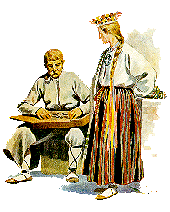
National Costumes
 The development of the national costumes reflects the history of the nation, from the first centuries A. D. - the formation of Baltic and Finno-Ugric tribes - Curonians. Semigallians, Latgallians, Selonians, Livs - developed in the territory of the present-day Latvia, till the 2nd half of the l9th century. Apart from ethnic features the costume also shows the social and marital status, age and wealth of the individual wearer, the centuries-old traditions, aesthetic ideals and creative spirit of the people, international cultural links, influence of professional art, urban culture, event fashion. The development of the national costumes reflects the history of the nation, from the first centuries A. D. - the formation of Baltic and Finno-Ugric tribes - Curonians. Semigallians, Latgallians, Selonians, Livs - developed in the territory of the present-day Latvia, till the 2nd half of the l9th century. Apart from ethnic features the costume also shows the social and marital status, age and wealth of the individual wearer, the centuries-old traditions, aesthetic ideals and creative spirit of the people, international cultural links, influence of professional art, urban culture, event fashion.
 Latvia falls into five ethnographic regions: Kurzeme, Vidzeme, Zemgale, Latgale, Augszeme, their distinctions reaching as far back as the ancient Balts and Finno-Ugrians. The feudal period with its territorial seclusion and total subjugation of serfs to their lords enhanced the regional and local varieties of the national costume. Regional borders were, however, not stricktly marked and a certain cultural interchange did exist. Regional variations were most pronounced in the proportions of woman's clothes, the cut and the colour-scheme, embroidery technique and composition , adornment of belts, socks and mittens. Headgear, outdoor clothes and footwear were not different. Headgear was the first item to undergo town influence through purchased material and new fashions. Latvia falls into five ethnographic regions: Kurzeme, Vidzeme, Zemgale, Latgale, Augszeme, their distinctions reaching as far back as the ancient Balts and Finno-Ugrians. The feudal period with its territorial seclusion and total subjugation of serfs to their lords enhanced the regional and local varieties of the national costume. Regional borders were, however, not stricktly marked and a certain cultural interchange did exist. Regional variations were most pronounced in the proportions of woman's clothes, the cut and the colour-scheme, embroidery technique and composition , adornment of belts, socks and mittens. Headgear, outdoor clothes and footwear were not different. Headgear was the first item to undergo town influence through purchased material and new fashions. 

© Una Shneidere - photo
|

 The development of the national costumes reflects the history of the nation, from the first centuries A. D. - the formation of Baltic and Finno-Ugric tribes - Curonians. Semigallians, Latgallians, Selonians, Livs - developed in the territory of the present-day Latvia, till the 2nd half of the l9th century. Apart from ethnic features the costume also shows the social and marital status, age and wealth of the individual wearer, the centuries-old traditions, aesthetic ideals and creative spirit of the people, international cultural links, influence of professional art, urban culture, event fashion.
The development of the national costumes reflects the history of the nation, from the first centuries A. D. - the formation of Baltic and Finno-Ugric tribes - Curonians. Semigallians, Latgallians, Selonians, Livs - developed in the territory of the present-day Latvia, till the 2nd half of the l9th century. Apart from ethnic features the costume also shows the social and marital status, age and wealth of the individual wearer, the centuries-old traditions, aesthetic ideals and creative spirit of the people, international cultural links, influence of professional art, urban culture, event fashion.

